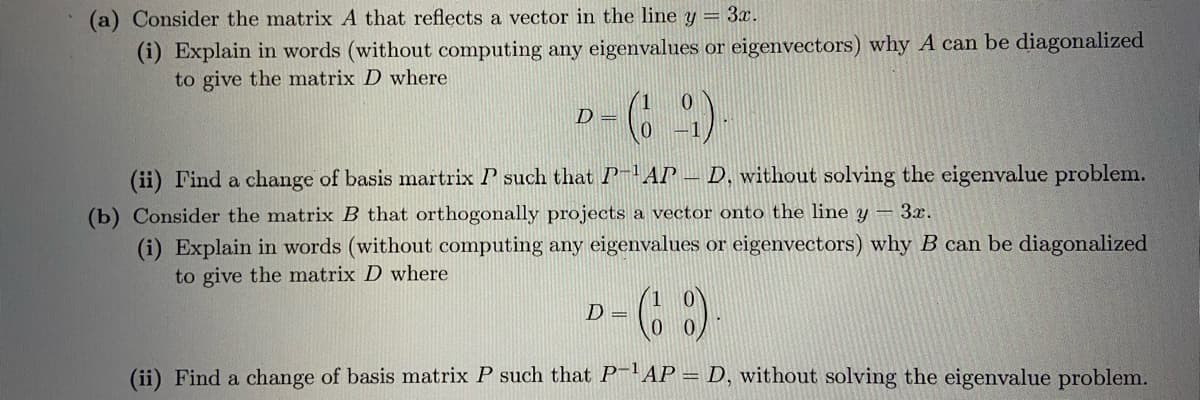(a) Consider the matrix A that reflects a vector in the line y = 3x. (i) Explain in words (without computing any eigenvalues or eigenvectors) why A can be diagonalized to give the matrix D where D = (ii) Find a change of basis martrix P such that P-'AP – D, without solving the eigenvalue problem. (b) Consider the matrix B that orthogonally projects a vector onto the line y - 3x. (i) Explain in words (without computing any eigenvalues or eigenvectors) why B can be diagonalized to give the matrix D where D = (ii) Find a change of basis matrix P such that P'AP = D, without solving the eigenvalue problem.
(a) Consider the matrix A that reflects a vector in the line y = 3x. (i) Explain in words (without computing any eigenvalues or eigenvectors) why A can be diagonalized to give the matrix D where D = (ii) Find a change of basis martrix P such that P-'AP – D, without solving the eigenvalue problem. (b) Consider the matrix B that orthogonally projects a vector onto the line y - 3x. (i) Explain in words (without computing any eigenvalues or eigenvectors) why B can be diagonalized to give the matrix D where D = (ii) Find a change of basis matrix P such that P'AP = D, without solving the eigenvalue problem.
Linear Algebra: A Modern Introduction
4th Edition
ISBN:9781285463247
Author:David Poole
Publisher:David Poole
Chapter5: Orthogonality
Section5.4: Orthogonal Diagonalization Of Symmetric Matrices
Problem 27EQ
Related questions
Question
100%

Transcribed Image Text:(a) Consider the matrix A that reflects a vector in the line y = 3x.
(i) Explain in words (without computing any eigenvalues or eigenvectors) why A can be diagonalized
to give the matrix D where
D =
(ii) Find a change of basis martrix P such that P-AP – D, without solving the eigenvalue problem.
(b) Consider the matrix B that orthogonally projects a vector onto the line y -3x.
(i) Explain in words (without computing any eigenvalues or eigenvectors) why B can be diagonalized
to give the matrix D where
D =
(ii) Find a change of basis matrix P such that P-'AP = D, without solving the eigenvalue problem.
Expert Solution
This question has been solved!
Explore an expertly crafted, step-by-step solution for a thorough understanding of key concepts.
Step by step
Solved in 2 steps

Knowledge Booster
Learn more about
Need a deep-dive on the concept behind this application? Look no further. Learn more about this topic, advanced-math and related others by exploring similar questions and additional content below.Recommended textbooks for you

Linear Algebra: A Modern Introduction
Algebra
ISBN:
9781285463247
Author:
David Poole
Publisher:
Cengage Learning

Algebra & Trigonometry with Analytic Geometry
Algebra
ISBN:
9781133382119
Author:
Swokowski
Publisher:
Cengage

Linear Algebra: A Modern Introduction
Algebra
ISBN:
9781285463247
Author:
David Poole
Publisher:
Cengage Learning

Algebra & Trigonometry with Analytic Geometry
Algebra
ISBN:
9781133382119
Author:
Swokowski
Publisher:
Cengage